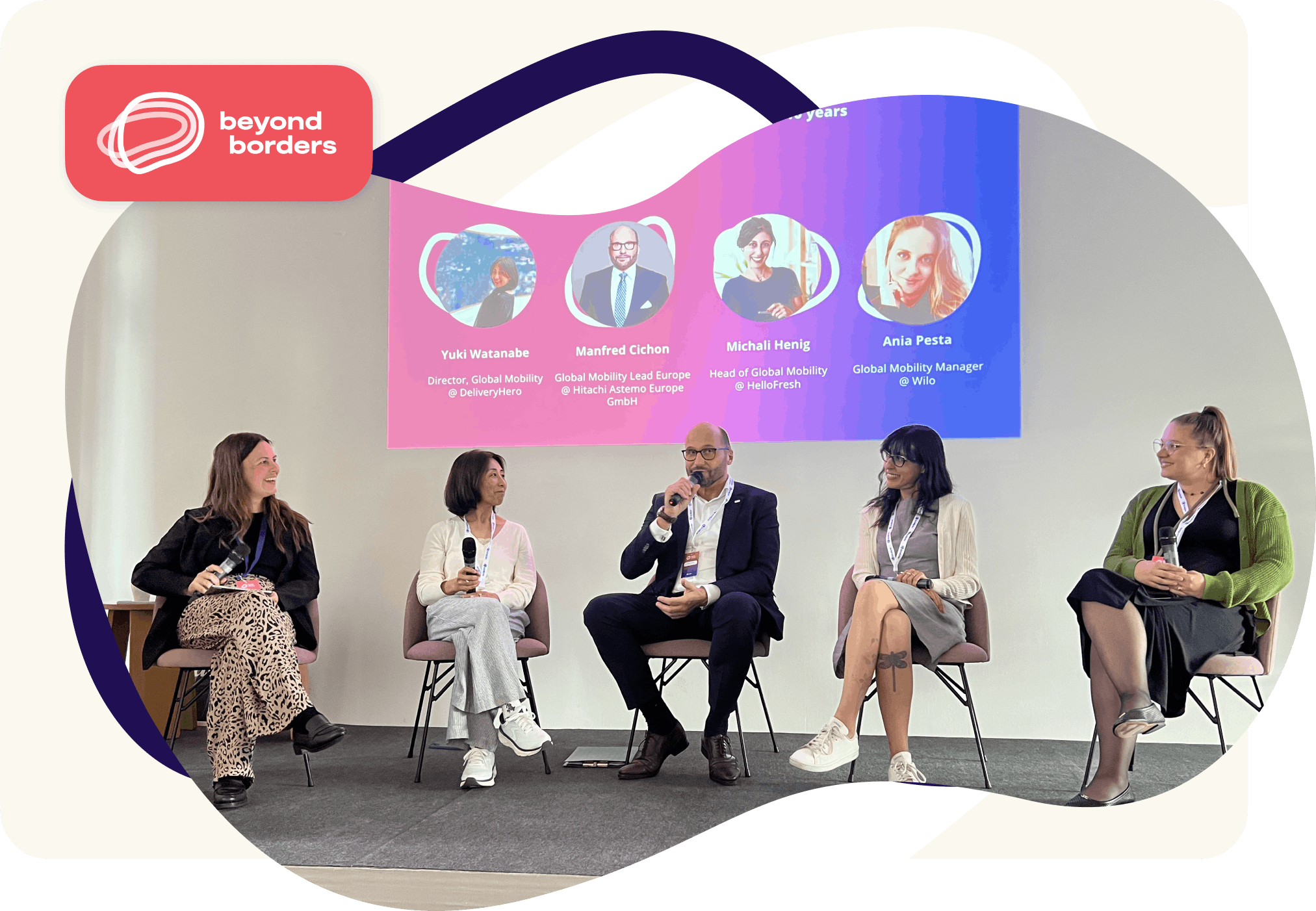Global mobility programmes are evolving faster than ever. With AI reshaping how we work, talent shortages challenging businesses, and new relocation patterns emerging - the way organizations move people across borders is entering a new chapter. At Beyond Borders Berlin, global mobility leaders shared their insights on what lies ahead. Here are the key predictions for 2026.
1. Artificial intelligence is poised to transform mobility operations
“AI is an enabler: it depends on how you use it. It must be used responsibly and respectfully.” – Yukiko Watanabe, Director of Global Mobility, Delivery Hero
AI adoption is accelerating, especially under U.S. business influence, but regulatory and labor law hurdles make implementation complex. As Manfred Cichon, Global Mobility Lead Europe, Astemo Europe noted, “In 10 years, a new generation of GM experts will be using AI every day.”
Leaders also agree it must be approached with care. For many, the shift feels seismic. Michali Henig, Head of Global Mobility, HelloFresh compared it to the early internet, predicting that the infrastructure of mobility will change completely. And as Ania Pesta, GM Manager at Wilo, added, “This is a transformative time. AI isn’t perfect, so we must question it. It’s exciting and terrifying at the same time.”
2. Talent shortages will continue and workforces will shift
Demographic changes are putting pressure on global talent pipelines. Europe’s workforce is aging, and organizations are increasingly looking abroad to fill high-skill roles.
“Europe is aging; where is the younger workforce? Talent shortages will only get worse.” – Ania Pesta, Global Mobility Manager, Wilo
Meanwhile, expectations among younger employees are shifting. Gen Z is prioritizing mental health, flexibility, and inclusivity in ways that challenge traditional relocation models. Long-term moves are giving way to short-term projects, hybrid setups, and virtual collaboration.
3. New global talent hubs will continue to emerge
Many regions are becoming increasingly attractive thanks to a mix of strong economic growth, pro-business policies, and large-scale investments in infrastructure and innovation. Competitive tax regimes, streamlined visa pathways, and ambitious government initiatives are drawing in global professionals, while high-quality healthcare, education, and lifestyle amenities make relocation appealing not just for employees but also for their families.
Many regions across the globe are positioning themselves as talent hubs, while Europe risks losing appeal due to housing shortages and rising costs of living. Here are the leading talent hubs attracting talent today:
- Dubai (along with Abu Dhabi) ranks first globally in “Ease of Entry” under Kearney’s Global Cities Index, making it top-tier for attracting international talent.
- In Saudi Arabia, the total workforce was about 17.2 million by Q3 2024, out of which 13.2 million are foreign workers (~77%)
- Singapore regularly ranks in the top 10 in global indices for expat destinations, especially for quality of life, ease of doing business, and stability.
4. Tech roles will remain central to global mobility
“We’ll definitely see engineers, but also critical talent across diverse fields.” – Yuki Watanabe
Future relocations will likely focus on roles requiring physical presence, while many others shift to remote-first structures. Yet, as Michali pointed out, the back-to-office trend is also gathering momentum. These two models are set to coexist, creating both opportunities and tensions for mobility teams.
While many roles are transitioning to remote-first structures, the necessity for in-person presence persists in certain sectors. Notably, the trend of "hybrid creep" is emerging, where companies are gradually increasing mandatory in-office workdays. For instance, 34% of U.S. full-time workers are now expected at the office four or more days weekly, up from 23% in 2023.
5. The role of the global mobility leader will become more strategic
“We need to develop human-centric thinking, becoming true strategic partners to the business.” – Ania Pesta
Across the board, communication, adaptability, resilience, and technical fluency were highlighted as essential skills. The ability to guide employees through stressful moves with empathy and clarity will remain critical, even as technology automates much of the operational work.
As Global Mobility evolves, leaders will need to balance strategic insight with operational excellence. Beyond traditional logistics, GM leaders are expected to guide workforce planning, influence talent strategy, and align mobility with broader business goals.
Soft skills are increasingly critical:
- Empathy and emotional intelligence: Understanding the stress, cultural adjustments, and personal challenges employees face during relocation.
- Communication: Clear, transparent guidance for employees, managers, and cross-functional stakeholders, especially in high-pressure scenarios.
- Adaptability and resilience: Navigating regulatory changes, geopolitical uncertainty, and fluctuating labor markets.
Hard skills are equally essential:
- Data literacy and analytical thinking: Using workforce data to forecast talent needs, assess mobility ROI, and measure employee satisfaction.
- Tech fluency: Leveraging Global Mobility platforms, AI tools, and automation to streamline processes without losing the human touch.
- Regulatory expertise: Staying ahead of complex immigration, tax, and compliance requirements across multiple jurisdictions.
The ideal GM leader of the future will combine these soft and hard skills, acting as a trusted advisor to business leaders while ensuring employees’ experiences remain seamless and supportive. In short, technology may automate operational tasks, but it cannot replace the strategic and human-centric role that Global Mobility leaders will play.
6. Geopolitical shifts will intensify global mobility challenges
The geopolitical landscape is undergoing significant transformations, with major immigration policy changes in both the United States and Europe. In the U.S., the Trump administration has implemented a proclamation restricting the entry of certain nonimmigrant workers, particularly H-1B visa holders, unless employers make substantial financial commitments. This move aims to prioritize American workers and reduce the influx of foreign labor.
The European Union has introduced the Pact on Migration and Asylum, a set of new rules managing migration and establishing a common asylum system at the EU level. These reforms aim to balance the need for skilled labor with the challenges of integration and public sentiment towards immigration.
These policy shifts are creating a more complex and unpredictable global mobility environment. People teams and Global Mobility leaders will need to enhance their agility, deepen their understanding of evolving immigration laws, and develop strategies to navigate these changes effectively. Maintaining a balance between compliance, operational efficiency, and the overarching people strategy will be crucial as organizations adapt to these geopolitical shifts.
Some key insights
To better understand these predictions, it’s helpful to look at the broader landscape:
- The EU projects that by 2030, nearly 20% of the European workforce will be over 65
- The EU Blue Card remains one of the most attractive work migration schemes, offering a clear path to residency and naturalization
- According to OECD data, the cost of employing a worker in Germany includes an additional ~21% on top of salary due to social contributions, a major factor in talent cost management
- Short-term assignments and project-based relocations are already rising, with a 25% increase globally between 2020 and 2023
Looking ahead
By 2026, global mobility will be defined by three intersecting forces: AI adoption, talent scarcity, and the policies that make regions more (or less) attractive to mobile workers.
As Michali Henig said: “We’re at the beginning of the second internet. Our life is going to look completely different.”
Yet one thing is clear: no matter how advanced technology becomes, global mobility will always be about people, not just processes. The challenge for leaders will be to balance innovation with humanity, ensuring that talent not only moves, but thrives.



